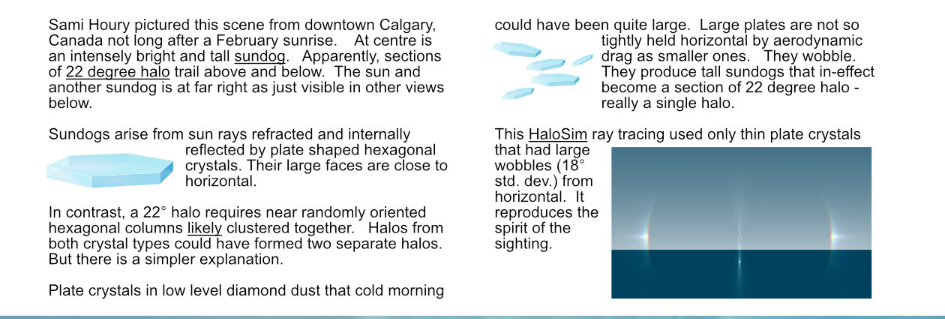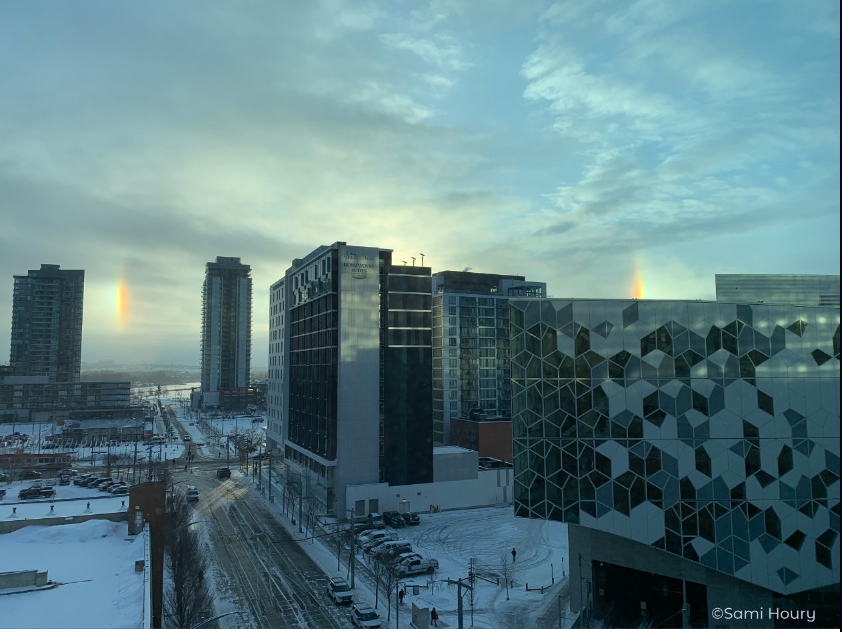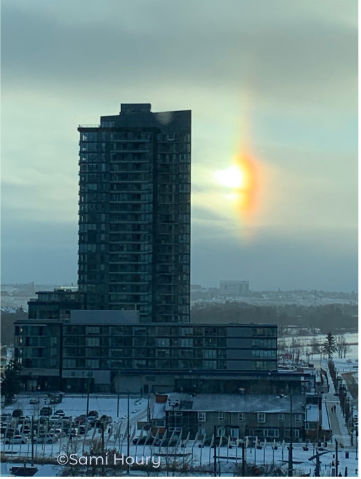Calgary halos from wobbly plate crystals
Calgary Halos from Wobbly Plate Crystals: A Spectacular Atmospheric Phenomenon
Have you ever witnessed a breathtaking display of halos in the sky? If you were lucky enough to be in downtown Calgary, Canada, on a cold February morning, you might have been treated to an extraordinary sight. Sami Houry captured an incredible scene featuring an intensely bright and tall sundog at the center, accompanied by sections of a 22-degree halo trailing above and below it. To the far right, another sundog was faintly visible. But what causes these mesmerizing optical phenomena?
Sundogs, also known as parhelia, materialize when sunlight is refracted and internally reflected by plate-shaped hexagonal ice crystals suspended in the atmosphere. These crystals have large, nearly horizontal faces that contribute to the formation of sundogs. On the other hand, a 22-degree halo requires hexagonal columns with near-random orientations, often clustered together. In theory, halos from both crystal types could have formed two separate halos. However, there is a simpler explanation.
On that chilly morning in Calgary, the plate crystals in the low-level diamond dust were likely larger than usual. Unlike smaller plates, larger ones are not as tightly held horizontal by aerodynamic drag, causing them to wobble. This wobbling motion resulted in the production of tall sundogs that effectively became a section of the 22-degree halo—a single halo instead of two separate ones.
To illustrate this phenomenon, HaloSim ray tracing was employed using only thin plate crystals with significant wobbles (standard deviation of 18 degrees from horizontal). This simulation successfully reproduced the essence of the sighting, supporting the hypothesis that wobbly plate crystals played a key role in creating the unique display observed in Calgary.
When sunlight interacts with a plate crystal to form a sundog, the same ray path can generate a 22-degree halo when the crystal takes the shape of a longer column and is randomly tilted. The path of the ray within the crystal is crucial for these optical phenomena to occur. In most cases, except when the sun is near the horizon, the ray must reflect up and down within the plate in order to escape through another side face, leading to the formation of sundogs and halos.
The large tilts and low position of the sun during the Calgary display necessitated internal reflections within the plate crystals, enhancing the intensity and complexity of the observed halos. In certain atmospheric conditions where there are multiple layers rich in ice crystals, sundogs can appear double or even triple, creating an even more captivating spectacle in the sky.
It's important to note that the phenomenon described here is just one example of the many atmospheric optics events that can occur. Each display is unique and influenced by various factors such as crystal shape, orientation, size, and atmospheric conditions. The interaction of sunlight with ice crystals in the atmosphere gives rise to a multitude of awe-inspiring optical phenomena, including halos, arcs, and even colorful displays like iridescence and circumhorizontal arcs.
So, next time you find yourself gazing at the sky and marveling at the beauty of halos, remember that behind their ethereal appearance lies a scientific explanation involving the intricate interplay between light and ice crystals suspended in our atmosphere. Nature never fails to astound us with its captivating wonders, and atmospheric optics offers us a fascinating glimpse into the hidden secrets of our skies.


Sami Houry pictured this scene from downtown Calgary, Canada not long after a February sunrise. At centre is an intensely bright and tall sundog. Apparently, sections of 22 degree halo trail above and below. The sun and
another sundog is at far right as just visible in other views below.
Sundogs arise from sun rays refracted and internally reflected by plate shaped hexagonal crystals. Their large faces are close to horizontal.

In contrast, a 22° halo requires near randomly oriented hexagonal columns likely clustered together. Halos from both crystal types could have formed two separate halos.
But there is a simpler explanation.

Plate crystals in low level diamond dust that cold morning could have been quite large. Large plates are not so tightly held horizontal by aerodynamic drag as smaller ones. They wobble.
They produce tall sundogs that in-effect become a section of 22 degree halo - really a single halo.

This HaloSim ray tracing used only thin plate crystals that had large wobbles (18° std. dev.) from horizontal. It reproduces the spirit of the sighting.


Another view of the arc curving upwards.
Ray path through a plate crystal to form a sundog. The same ray path forms a 22 halo when the crystal is a longer column and randomly tilted.
Except when the sun is near to the horizon, the ray must reflect up and down within the plate in order to escape through another side face.

The large tilts and low sun of the Calgary display necessitate internal reflections.
Sundogs appear double or triple when there are layers rich in crystals.

Note: this article has been automatically converted from the old site and may not appear as intended. You can find the original article here.
Reference Atmospheric Optics
If you use any of the definitions, information, or data presented on Atmospheric Optics, please copy the link or reference below to properly credit us as the reference source. Thank you!
-
<a href="https://atoptics.co.uk/blog/calgary-halos-from-wobbly-plate-crystals/">Calgary halos from wobbly plate crystals</a>
-
"Calgary halos from wobbly plate crystals". Atmospheric Optics. Accessed on November 26, 2024. https://atoptics.co.uk/blog/calgary-halos-from-wobbly-plate-crystals/.
-
"Calgary halos from wobbly plate crystals". Atmospheric Optics, https://atoptics.co.uk/blog/calgary-halos-from-wobbly-plate-crystals/. Accessed 26 November, 2024
-
Calgary halos from wobbly plate crystals. Atmospheric Optics. Retrieved from https://atoptics.co.uk/blog/calgary-halos-from-wobbly-plate-crystals/.